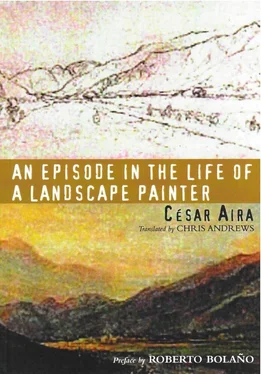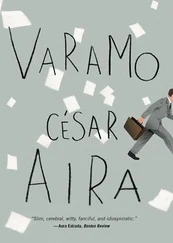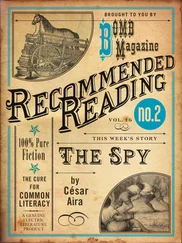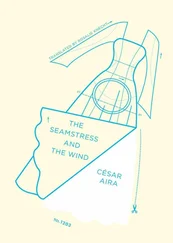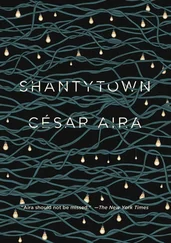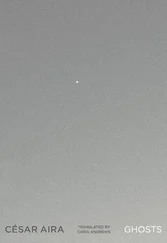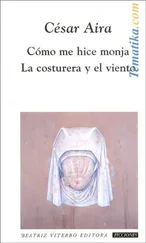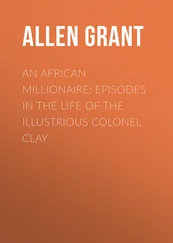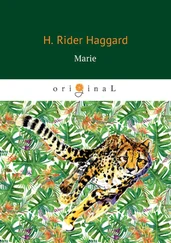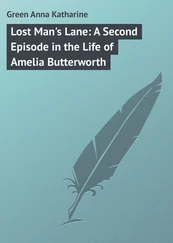Cesar Aira - An Episode in the Life of a Landscape Painter
Здесь есть возможность читать онлайн «Cesar Aira - An Episode in the Life of a Landscape Painter» весь текст электронной книги совершенно бесплатно (целиком полную версию без сокращений). В некоторых случаях можно слушать аудио, скачать через торрент в формате fb2 и присутствует краткое содержание. Год выпуска: 2006, Издательство: New Directions, Жанр: Современная проза, на английском языке. Описание произведения, (предисловие) а так же отзывы посетителей доступны на портале библиотеки ЛибКат.
- Название:An Episode in the Life of a Landscape Painter
- Автор:
- Издательство:New Directions
- Жанр:
- Год:2006
- ISBN:нет данных
- Рейтинг книги:5 / 5. Голосов: 1
-
Избранное:Добавить в избранное
- Отзывы:
-
Ваша оценка:
- 100
- 1
- 2
- 3
- 4
- 5
An Episode in the Life of a Landscape Painter: краткое содержание, описание и аннотация
Предлагаем к чтению аннотацию, описание, краткое содержание или предисловие (зависит от того, что написал сам автор книги «An Episode in the Life of a Landscape Painter»). Если вы не нашли необходимую информацию о книге — напишите в комментариях, мы постараемся отыскать её.
An Episode in the Life of a Landscape Painter
An Episode in the Life of a Landscape Painter — читать онлайн бесплатно полную книгу (весь текст) целиком
Ниже представлен текст книги, разбитый по страницам. Система сохранения места последней прочитанной страницы, позволяет с удобством читать онлайн бесплатно книгу «An Episode in the Life of a Landscape Painter», без необходимости каждый раз заново искать на чём Вы остановились. Поставьте закладку, и сможете в любой момент перейти на страницу, на которой закончили чтение.
Интервал:
Закладка:
His first and principal correspondent was his sister Luise, back in his hometown of Augsburg. With her he was touchingly sincere. He had never hidden anything from her and could not see why he should do so now. Yet at this juncture he discovered that Luise could not take in the whole range of possible documentation. Or, rather: although she could (because there were no secrets between them), certain things would be left out. This was one of those situations in which the whole is not enough. Perhaps because there were other "wholes," or because the "whole" made up by the speaker and his personal world rotates like a planet, and the combined effect of rotation and orbital movement is to keep certain sides of certain planets permanently hidden. To use a modern term, which does not appear in the letters, we might call this a problem of "discursive form." As if he had been aware of it from the start, Rugendas had prudently built up a range of correspondents scattered around the globe. So now he resumed the task of writing to other addresses; among his interlocutors he counted physiognomic painters and naturalists, ranchers, farmers, journalists, housewives, rich collectors, ascetics and even national heroes. Each set the tone for a different version, but all the versions were his. The variations revolved around a curious impossibility: how could he communicate the proposition "I am a monster"? It was easy enough to set it down on paper. But transmitting its significance was far more difficult. In the case of his Chilean friends the problem was pressing, and he took particular care over his letters to them, especially the Guttikers, who had already written inviting him to stay at their house in Santiago, as he had before setting out on his journey a few months before. Since they would be seeing him shortly, he felt he had to warn them. The obvious thing to do in this case would have been to exaggerate, in order to diminish the surprise. But it was not easy to exaggerate, given the state of his face. He ran the risk of falling short, especially if they were allowing for obvious exaggeration. Which would make the surprise even worse.
In any case, he certainly did not shut himself away. His body's natural regimen required a good deal of fresh air and exercise. And even in his semi-invalid state, in spite of the frequent migraines, the nervous attacks and the constant medication, it became imperative for him to dedicate the hours of good daylight to riding and painting the natural world. The faithful Krause never left his side, because the attacks could occur far from the house, in which case he would hoist Rugendas onto his own horse and gallop back, undaunted by the cries of pain. Those spectacular crises were not, however, the most remarkable aspect of their outings. Rugendas attracted a great deal of attention even when he was behaving with perfect calm and propriety. People gathered to look at him, and in half-civilized places like the picturesque environs of Mendoza, one could hardly expect discretion to be the rule. The children were not the worst, because the adults behaved like children too. They watched him intently drawing the large hydraulic devices used for irrigation (his latest enthusiasm), and they were consumed by the desire to see his papers. What did they imagine? As for Rugendas, each time he took up his pencil he had to resist the temptation to sketch himself.
At summer's end the weather had attained ultimate perfection. The landscapes took on an infinite plasticity; the shifting light of the Cordillera enveloped them hour by hour, made them transparent, endless cascades of detail. The afternoon light, filtered by the imposing stone ramparts of the Andes, was a ghost of its morning self, an optics of the mind, inhabited by the untimely pinks of mid-afternoon.
Twilight went on for ten or twelve hours. And during the friends' night walks, gusts of wind rearranged stars and mountains. If it was true, as the Buddhists said, that everything, even a stone, a dead leaf or a blowfly, had already existed and would exist again, that everything was part of a great cycle of rebirths, then everything was a man, a single man on the scale of time. Any man, Buddha or a beggar, a god or a slave. Given sufficient time, all the elements of the universe would combine to form a man. This had major consequences for the procedure: for a start, it could not operate automatically like a transcendent mechanics, with each fragment being slotted into its predetermined place; each fragment could become any other, and the transformation would be accomplished not in the dimension of time but in that of meaning. This idea could give rise to a totally different conception of reality. In his work, Rugendas had come to the conclusion that the lines of a drawing should not represent corresponding lines in visible reality, in a one-to-one equivalence. On the contrary, the line's function was constructive. That was why the practice of drawing remained irreducible to thought, and why, although he had completely incorporated the procedure, he could continue to draw.
The Godoys had still not grown accustomed to his new appearance. This was an interesting sign of things to come. People can get used to any deformity, even the most frightful, but when it is accompanied by an uncontrollable movement of the features, a fluid, senseless movement, habit has no stable base on which to build. Perception remains correspondingly fluid. Although sociable and talkative by nature, Rugendas began to retire shortly after dinner and spend the evenings on his own. This he could do without awkwardness, since he had a legitimate excuse: struck down by superhuman migraines, he was at first incapable of anything but writhing on the bed of his attic room… and not only the bed, on the floor too, and the walls, and the ceiling…when the medication took effect, he returned to his letters.
In his writing he tried to be absolutely sincere. He reasoned as follows: in principle, telling the truth and lying require the same amount of effort, so why not tell the truth, without omissions or ambiguities? If only as an experiment. But this was easier to say than to do, especially since in this case the doing was a kind of saying.
Perhaps the morphine would never be metabolized. Perhaps he was entering a second or a third phase. Or was the combination of the opiate, the migraines and the nervous meltdown of a physiognomic landscape painter producing an unprecedented result? In any case the concept of truth took on monstrous proportions in his imagination, and rent his nights in the little rooftop room.
The letters from this period are much concerned with an apparently extraneous matter, to which Rugendas returns obsessively, like a monomaniac. His book A Picturesque Voyage through Brazil , the basis of his considerable fame throughout Europe, had in fact been written by someone else, the French journalist and art critic Victor Aimé Huber (1800–1869), using Rugendas's manuscript notes. Although this had not struck him as irregular at the time, it now seemed very odd indeed, and he wondered how he could have consented to such a scheme. Surely it was fraudulent to publish a book under the signature of X when it had in fact been written by Y? He had been so distracted by the whole process of the publication, which was absurdly complicated because of the nature of the book, that he had agreed without thinking. There were so many tasks involved, from financing the project to the coloring of the plates; the writing of the text seemed a mere detail. The lithographs were the book's main attraction: a hundred of them, executed by French artists, except for three, which Rugendas had done himself. Although the lithographers, Engelmann & Co., had a well-deserved reputation as the finest in Europe, he still had to supervise the preparation of the lithographs in person and in minute detail; the process consisted of various stages and was beset with pitfalls. He had thought of the text as an accompaniment to the images; but what he had not seen at the time, and was now beginning to realize, was that by considering it an accompaniment or a complement he was separating the text from the "graphic" content. And the truth, he now saw, was that both were part of the same thing. Which meant that the ghost-writer, the "nègre," had infiltrated the very essence of the work, under the pretext of carrying out a purely technical task: making coherent sentences out of the disjointed scraps of oral documentation. But everything was documentation! That was where it all began and where it ended too. Where it began especially (because the end was far off down the misty ways of science and art history). Nature itself, preformed by the procedure, was already documentation. There were no pure, isolated data. An order was implicit in the phenomenal revelation of the world; the order of discourse shaped things themselves. And since his current mental state was part of that order, he would have to examine it and find rational explanations for what seemed to be a visionary or maniacal chaos. It should be added here that Rugendas was not medicating himself with pure morphine — which could not be synthesized at the time — but with a tincture of opium in a bromide solution. This combined the benefits of the best analgesic and those of the best anti-depressant. His face twitched like a second hand timing an eternity of Buddhist reincarnations. It was one way to cure the "publishing pains" resulting from his past errors of judgement.
Читать дальшеИнтервал:
Закладка:
Похожие книги на «An Episode in the Life of a Landscape Painter»
Представляем Вашему вниманию похожие книги на «An Episode in the Life of a Landscape Painter» списком для выбора. Мы отобрали схожую по названию и смыслу литературу в надежде предоставить читателям больше вариантов отыскать новые, интересные, ещё непрочитанные произведения.
Обсуждение, отзывы о книге «An Episode in the Life of a Landscape Painter» и просто собственные мнения читателей. Оставьте ваши комментарии, напишите, что Вы думаете о произведении, его смысле или главных героях. Укажите что конкретно понравилось, а что нет, и почему Вы так считаете.
